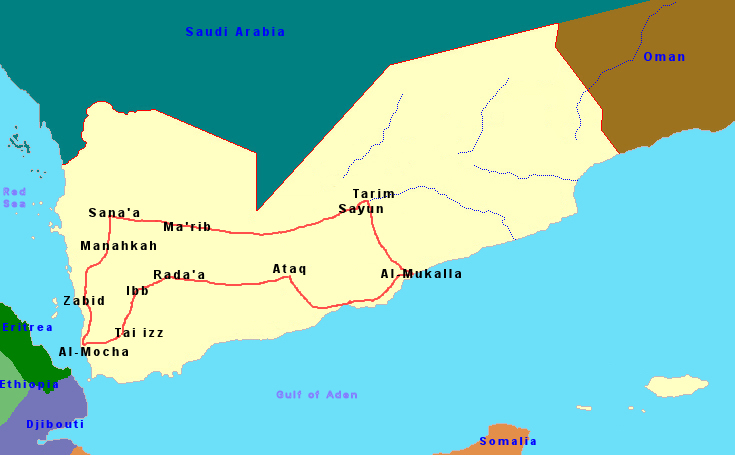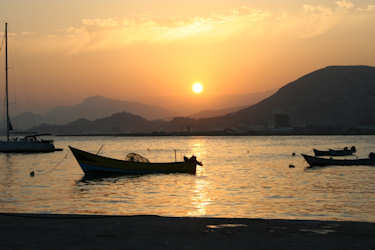Yemen

Historie
With its long sea border between eastern and western civilizations, Yemen has long existed at a crossroads of cultures with a strategic location
in terms of trade on the west of the Arabian Peninsula. Large settlements for their era existed in the mountains of northern Yemen as early as
5000 BC.
Between the eighth century BCE and the sixth century CE, it was dominated by six main states which rivaled each other, or were allied with each
other and controlled the lucrative spice trade: Saba, Ma'in, Qataban, Hadhramaut, Kingdom of Awsan and the
Himyarite Kingdom.
The Sabaean Kingdom came into existence from at least the 11th century BC. The Sabaean rulers adopted the title Mukarrib generally
thought to mean "unifier" or a "priest-king" or the head of the confederation of South Arabian kingdoms, the "king of the kings".
The role of the Mukarrib was to bring the various tribes under the kingdom and preside over them all.
Between 700 and 680 BCE, the Kingdom of Awsan dominated Aden and its surroundings and challenged the Sabaean supremacy in the Arabian South.
Sabaean Mukarrib Karib'il Watar I conquered the entire realm of Awsan and expanded Sabaean rule and territory to include much of South
Arabia. Lack of water in the Arabian Peninsula prevented the Sabaeans from unifying the entire peninsula. Instead, they established various colonies
to control trade routes.
Evidence of Sabaean influence is found in northern Ethiopia, where the South Arabian alphabet, religion and pantheon, and the South Arabian style
of art and architecture were introduced.
The Sabaean created a sense of identity through their religion. They worshipped El-Maqah (" Moon God") and believed that they were
his children. For centuries, the Sabaeans controlled outbound trade across the Bab-el-Mandeb, a strait separating the Arabian Peninsula
from the Horn of Africa and the Red Sea from the Indian Ocean.
By the third century BC, Qataban, Hadramaut, and Ma'in became independent from Saba and established themselves in the Yemeni
arena.
The Himyarite Kingdom, established in 110 BC took as its capital the ancient city of Zafar, to be followed at the beginning of the
4th century by what is the modern-day city of Sana'a. The kingdom conquered neighbouring Saba' in 25 BC, Qataban in 200 AD, and Hadramaut
300 AD. Its political fortunes relative to Saba' changed frequently until it finally conquered the Sabaean Kingdom around 280 AD.
Himyar then endured until it finally fell to invaders from the Kingdom of Aksum in 525 AD.
The Persian king Khosrau I, sent troops under the command of Vahriz, who helped the semi-legendary Sayf ibn Dhi Yazan to drive
the Aksumites out of Yemen. Southern Arabia became a Persian dominion under a Yemenite vassal and thus came within the sphere of influence of
the Sassanid Empire.
Islam came to Yemen around 630 during Muhammad's lifetime and the rule of the Persian governor Bădhăn ibn Săsăn. Thereafter, Yemen was
ruled as part of Arab-Islamic caliphates, and became a province in the Islamic empire.
Local control in the Middle Ages was exerted by a succession of families which included the Ziyadids (818–1018), the Najahids
(1022–1158), the Egyptian Ayyubids (1174–1229), the Turkoman Rasulids (1229–1454) and the Tahirids (1454–1517).
The most long-lived, and for the future most important polity, was founded in 897 by Yayha bin Husayn bin Qasim ar-Rassi. They were the
Zaydis of Sa'dah in the highlands of North Yemen, headed by imams of various Sayyid lineages. As ruling Imams of Yemen, they established
a Shia theocratic political structure that survived with some intervals until 1962.
The Mamluk regime in Egypt began to dispatch seaborne expeditions towards the south after 1507, since the presence of the Portuguese
constituted a threat in the southern Red Sea region.
Shortly after the Mamluk conquest in 1517, Egypt itself was conquered by the Ottoman sultan Selim I. The Mamluk militaries formally
recognized the Ottomans until 1538, when regular Turkish forces arrived. At this time the Ottomans began to worry about the Portuguese who
occupied Socotra Island. The Ottomans eliminated the last Tahirid lord in Aden and the Mamluk military leadership, and set up an administration
based in Zabid. The Portuguese blockade of the Red Sea was broken. The first Turkish occupation lasted until 1635.
The imam al-Mansur al-Qasim (r. 1597–1620) belonged to one of the branches of the Rassid (descendants of the first imam or his
close family). The new line became known as the Qasimids after its founder. Al-Mansur's son al-Mu'ayyad Muhammad
(r. 1620–1644) managed to gather Yemen under his authority, expel the Turks, and established an independent political entity.
The centre of the imamic state was San'a and its economic base was strengthened by the coffee trade of the coastal entrepot Mocha.
Coffee had been introduced from Ethiopia in about 1543, and Yemen held a monopoly on this product for a long time. Merchants from Gujarat
frequented Yemen after the withdrawal of the Turks, and European traders established factories after 1618.
The power of the imamate declined in the 18th and 19th century.
Ottoman interest in Yemen was renewed in the mid-19th century. One aim was to increase Ottoman influence in the Red Sea trade, especially since
the British occupied Aden since 1839. The opening of the Suez Canal in 1869 increased this incentive.
The Tihama was occupied in 1849 and in 1872 a new expedition secured Sana'a. The dissolution of the Ottoman Empire after World War I led to a
complete withdrawal in 1918.
On 30 October 1918, following the collapse of the Ottoman Empire, Imam Yahya Muhammad of the al-Qasimi dynasty declared Northern Yemen
an independent sovereign state.
Imam Yahya was assassinated in an unsuccessful coup d'état in 1948, but was eventually succeeded by a firm heir - Yahya's son, Imam Ahmad bin
Yahya, who regained power several months later. Imam Ahmad died in September 1962, and was succeeded by his son, the Crown Prince Muhammad
al-Badr.
The North Yemen Civil War began with a coup d'état carried out in 1962 by revolutionary republicans led by the army under the command of
Abdullah as-Sallal, who dethroned the newly crowned Imam Muhammad al-Badr took control of Sana'a, and created the Yemen Arab Republic
(YAR). The Imam escaped to the Saudi Arabian border where he rallied popular support from northern Shia tribes to retake power, escalating rapidly
to a full-scale civil war. On the royalist side, Jordan, Saudi Arabia and Israel supplied military aid, and Britain gave covert support, while
the republicans were supported by Egypt and were supplied warplanes from the Soviet Union.
Conflict continued periodically until 1967, when Egyptian troops were withdrawn to join the conflict of the Six-Day War. By 1968, following
a final royalist siege of Sana'a, most of the opposing leaders reached a reconciliation. Saudi Arabia recognized the Republic in 1970.
South Yemen's origins can be traced to 1874 with the creation of the British colony of Aden and the Aden Protectorate, which consisted
of two-thirds of the present-day Yemen.
On 30 November 1967, the state of South Yemen was formed, comprising Aden and the former Protectorate of South Arabia. This socialist state
was later officially known as the People's Democratic Republic of Yemen and a programme of nationalisation was begun.
Relations between the two Yemeni states fluctuated between peaceful and hostile. The South was supported by the Eastern bloc. The North, however,
wasn't able to get the same connections.
In 1972, the two states fought a war. The war was resolved with a ceasefire and negotiations brokered by the Arab League, where it was
declared that unification would eventually occur. In 1978, Ali Abdallah Saleh was named as president of the Yemen Arab Republic.
Fighting broke out again in February and March 1979, with South Yemen allegedly supplying aid to rebels in the north by the National Democratic
Front and crossing the border. Southern forces made it as far as the city of Taizz before withdrawing. This conflict was also short-lived.
In November 1989, Ali Abdullah Saleh of North Yemen and Ali Salim al-Beidh of South Yemen jointly accepted a draft unity constitution
originally drawn up in 1981, which included a demilitarized border and border passage by Yemenis on the sole basis of a national identification
card and a capital city in Sana'a. The Republic of Yemen was declared on 22 May 1990.
The First Yemeni Civil War was a civil war fought between the two Yemeni forces of the pro-union northern and the socialist separatist
southern Yemeni states and their supporters. The war resulted in the defeat of the southern armed forces, the reunification of Yemen, and the
flight into exile of many Yemeni Socialist Party (YSP) leaders and other separatists.
Adopting a Western style governmental system, Yemen held its first direct presidential elections in September 1999, electing President Ali
Abdullah Saleh to a 5-year term in what were generally considered free and fair elections. Yemen held its second multiparty parliamentary
elections in April 1997. Constitutional amendments adopted in the summer of 2000 extended the presidential term by 2 years, thus moving the
next presidential elections to 2006.
Friction and troubles continued, elements in the south perceive unfair treatment by the north. This has given birth to a popular movement called
the South Yemen Movement which calls for the return of an independent southern state. In 2015, Yemen again was engulfed in civil war,
which continues to this day.
I visit Yemen in april 2007
These are the places I have seen on that trip
Sana'a
Ma'rib
Sayun
Tarim
Al-Mukalla
Ataq
Rada'a
Ibb
Ta'izz
Al-Mocha
Zabid
Manahkah
Please let me know when you're having questions.
i would be pleased to help you.
i would be pleased to help you.
Things to do and other tips
